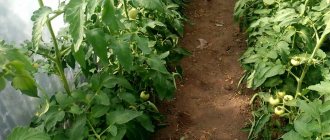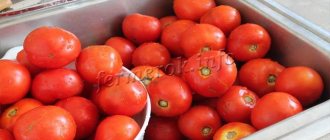Description of the variety
A determinate bush of standard type has a compact root system, thanks to which the plant does not require a large area in the garden bed for its nutrition. The multiple-fruited stem is stable and can withstand fruit-laden clusters.
The bush grows up to 50-60 cm, and under favorable conditions up to 80 cm. The plant has an average amount of foliage, which has a dense structure and a rich light green hue. The brushes are formed at a distance of 10 cm and bear 5-6 flowers. With the appearance of the third leaf, the first ovaries begin to form, and the next peduncles are formed through two leaves.
Distinctive features
The Gigolo variety is distinguished by its universal use of fruits. Tomatoes tolerate transportation well, which makes them suitable for growing for sale. Tomatoes are often picked brown; they ripen well outside the garden and are stored for a long time.
Fruit characteristics and yield
Tomatoes are oblong in shape, like a cylinder with bulges. Their length varies from 8-9 to 12-15 cm, and their diameter is from 3 to 4 cm. The weight of one fruit is 100-130 g. Tomatoes have a dense red skin, do not crack, and the fleshy pulp contains few seeds. The texture of the fruits is not too juicy, sometimes even dry, but the taste is pleasant, sweetish, with a slight sourness.
Tomatoes of the Gigolo variety ripen in an average time. The crop begins to bear fruit 95-106 days from the beginning of sprout development. Growing tomatoes in heated greenhouses gives an earlier harvest. One bush of this variety produces on average up to 2-3 kg of tomatoes, and in greenhouse conditions even 5 kg. From 1 sq. m, vegetable growers harvest 8-15 kg of fruit.
On a note . The fruits of the Gigolo variety ripen at the same time.
Productivity
One of the main advantages of this unusual variety is its high yield. Zhigalo enters the fruiting phase in the middle period: 100-105 days pass from the appearance of the first shoots to the harvesting of the fruits.
Up to 6 sausage fruits are formed in one fruit cluster.
The friendly ripening of tomatoes in the brush allows them to be cut on a branch. During the season you can remove 2.5...3 kg from one bush. A good indicator for open ground, taking into account the light weight of the tomatoes themselves.
When planting Zhigalo in a greenhouse, you can achieve a higher yield - 5 kg / bush. Taking into account compact planting, in general, the yield is 8...15 kg/m2.
How to grow seedlings
From the moment of sowing the seeds for seedlings until the plant is planted in open ground, two months pass. If planting is planned in May, then the grains are sown in mid-March. At this time, daylight hours increase and the plants will receive sufficient heat and light.
For your information . Vitamin C is found most in the jelly-like liquid that surrounds the seeds.
Seed preparation
First of all, pay attention to the presence of a stamp on the packaging, on which the manufacturer indicates whether the seeds have been pre-treated. Sometimes unprocessed seed material is sold. In this case, the grains are prepared independently.
To do this, you will need to prepare a special solution, which includes the following ingredients:
- phytosporin;
- aloe juice;
- potassium permanganate.
The seeds are kept in this composition for 5-8 minutes, after which they are thoroughly rinsed under running water. Planting wet seeds is not recommended. They need to be dried well and only then will they be ready for planting.
Container and soil
Store-bought seedling boxes will last a long time, but you can also use what you have at home: cut-off plastic bottles, disposable cups, pre-assembled and washed juice or milk boxes.
Another good option is peat tablets. They will need to be moistened and the seeds placed in the swollen soil. The seedling store also sells containers with cells and a lid.
Tomato seedlings need loose and light soil. The best option would be to purchase a ready-made mixture with a specially developed composition, but you can prepare it yourself. To do this, you will need to mix two parts of garden soil and one part each of peat and sand in a large container. A day before sowing, the soil mixture is disinfected with boiling water.
Sowing
Before planting, the soil is moistened and holes 2 cm deep are made in it. Seeds are placed in them and sprinkled with earth or clean peat. After sowing, watering is carried out with warm, settled water. Moisten with a sieve or spray bottle so as not to wash the seeds out of the soil, then cover the container with film and place in a warm place with an air temperature of at least 21˚C.
Important ! Seedlings should not be over-watered. Even if the top layer of soil has dried out, the soil inside the container remains quite moist for some time.
Growing and care
When the first shoots appear, the seedlings are placed on a well-lit windowsill. But in cloudy weather, when there is practically no sun, artificial lighting is used. The correct development of sprouts and the fertility of the plant depend on the amount of ultraviolet radiation.
After 30-40 days, the tomato seedlings are hardened off. The containers are taken outside for an hour or two, then this time is increased.
Diseases and pests
Despite the lack of good immunity, unlike hybrids, the Zhigalo tomato is practically not susceptible to them. Therefore, as a preventative measure, tomato seedlings are treated with fungicidal preparations. Plantings are also regularly inspected for the presence of Colorado potato beetles. Mature plants are more resistant to diseases, but there is a risk of late blight. However, with sufficient care and control, diseases can be avoided.
| Gray rot Ways to fight:
| |
| Root cancer Ways to fight:
| |
| Caterpillars Ways to fight:
|
How to grow tomatoes
When the seedlings grow to 20 cm, the plant is ready to be transplanted into open ground. Landing dates depend on the region, but not earlier than mid-May. They are also planted in the greenhouse in the early days.
Landing
When planting seedlings in a permanent place of growth, it is important to remember that the bushes should not be planted too close to each other. The distance between them should be approximately 50-60 cm. If you do not adhere to this rule, the yield will decrease.
Care
The Gigolo tomato variety does not require special attention and care. Avoid excessive soil moisture, since the root system of the crop is located close to the soil surface. After watering, be sure to loosen so that the roots receive more oxygen. Moistening is carried out as the soil dries.
Important ! The stems and trunk of the plant are not watered.
The fewer branches there are on the stem, the larger the tomatoes will be, so pinching is carried out at will. The lateral shoots are carefully trimmed, retreating 1–2 cm from the stem.
The first fertilizing is applied 2-3 days after thinning the rows. Fertilize with ammonium nitrate (15 g per 10 liters of water). You will need to pour a liter of solution under each bush. After fertilizing, the soil is mulched.
The second feeding of tomatoes is carried out as soon as fruits begin to set on the bushes. For fertilizer, use a mineral mixture (10 g of potassium chloride and 20 g of superphosphate per 1 sq. m). Fertilizer is buried and the soil is moistened. To do this, shallow grooves (5-6 cm) are made along the rows at a distance of 15-20 cm from the plants.
When fertilizing the soil, nitrogen fertilizers are used carefully. Their excessive use will lead to increased growth of the bush and abundant growth of green mass. If there are no ready-made mineral fertilizers, then organic fertilizer is perfect.
To prepare a mullein infusion, stir a quarter of a bucket of manure into 10 liters of water and let it steep for 10-12 days. Before fertilizing, dilute the solution again (a liter of fertilizer per bucket of water). Feeding consumption: per 1 sq. m pour 10 liters of diluted infusion.
Features of cultivation and possible difficulties
Growing Gigolo tomatoes is no different from cultivating other varieties of tomatoes, that is, using seedlings. This means that seeds are sown in special boxes in March-April, two months before the seedlings are supposed to be planted in open ground or a greenhouse.
Attention ! The Gigolo variety is grown in all regions of the Russian Federation.
Diseases and pests
Gigolo has average resistance to disease. To prevent fungal diseases, the following measures are taken:
- mulch the soil;
- remove diseased and yellow leaves in a timely manner;
- disinfect planting material;
- remove weeds.
To prevent plants from being affected by diseases, the crop is maintained by applying complex mineral fertilizers. When the air temperature drops, plants are treated with agents that prevent late blight infection. Tomatoes are sprayed with a solution of fungicides and Bordeaux mixture.
Mole crickets, slugs and aphids are often found in a tomato garden. Sprinkling hot red pepper, mustard, and granules of the drug “Thunderstorm” helps against pests that move along the ground.
Aphids and other insects are destroyed with the drug “Fitoverm”. Garlic infusion also helps against pests. To prepare, add 200 g of grated garlic or onion to 10 liters of water, and let it brew for a day.
Diseases and pests of tomato.
Features of cultivation
Even a gardener can grow a Zhigalo tomato and get a normal harvest. It is absolutely unpretentious and requires minimal care.
Zhigalo is grown by seedlings. After the threat of return frosts (in May-early June), the seedlings are transplanted into beds. The optimal age of seedlings is 55...60 days.
Since the bushes are very compact with a poorly developed root system, their feeding area is somewhat smaller than that of many other varieties. Thanks to this, the bushes can be planted according to a compacted planting pattern.
Using this planting scheme, it is necessary to maintain a distance between neighboring seedlings of 30...40 cm, for row spacing -60 cm. Thus, 4...6 bushes can be placed per 1 m2 of planting area.
According to the originator, Zhigalo does not need support or garter. In southern regions with a warm climate, you can follow this recommendation and not tie up the bushes.
When growing outdoors in colder regions of the country, it is better to tie the bushes to stakes. The fact is that the branches of the bush can fall under the weight of the tomatoes, which will end up on the ground. Cool and damp summers will provoke the development of diseases and rotting of fruits.
A gigolo doesn't need a stepchild. Some gardeners plant stepsons at their own discretion.
Zhigalo responds well to attentive attention to itself, or rather to standard care measures. Like any other varietal tomatoes, for good fruiting, it needs weeding, watering, and loosening. Mulching will help make these activities easier.
Since the variety is quite susceptible to diseases, it is recommended to treat the bushes weekly with folk remedies. Fertilizing is carried out in accordance with the standard schedule, do not forget about foliar spraying with a solution of boric acid 2 weeks after planting.
The nuances of growing in open ground and in a greenhouse
Since the variety is low-growing and has a strong stem, it is believed that the crop does not need staking. However, when a large amount of crop ripens, the bush may fall over in a strong gust of wind.
To avoid this, supports for tomatoes are placed during the preparation of the holes. In areas with warm climates they do without them. The bushes are laid on the ground, protecting the soil from drying out. The soil is pre-mulched.
On a note. In regions with cool climates, a garter is required. If the fruits fall to the ground under such conditions, the plant may become sick.
Disease resistance
The varietal tomato crop Zhigalo weakly resists late blight. To prevent the disease, the following preventive measures are taken:
- soil mulching;
- weed and pest control;
- disinfection of seeds before planting;
- Regular removal of yellowed and diseased foliage.
Late blight is a fungus that affects both the plant and its fruits. The cause of the appearance and spread of the disease is high humidity and low temperature. Therefore, during sudden cold snaps and worsening weather, the bushes are sprayed with fungicides (Quadris, Ridomil Gold are suitable). Bordeaux mixture is also used.
Attention! To get rid of fungal diseases on Zhigalo tomatoes, folk remedies are used. The bushes are sprayed with fermented milk products, which cope well with late blight.
Like any other nightshade crop, tomatoes are attacked by the Colorado potato beetle. The fight against it involves collecting larvae and adults. In a greenhouse with high humidity, aphids may appear. You can avoid pest invasions with regular ventilation and proper watering.
As can be seen from the description, the standard variety Zhigalo is worthy of close attention, as it gives a good harvest, requiring minimal care. Therefore, it is often bred by beginning gardeners, who gradually move on to more refined and rare varieties.
Advantages and disadvantages of the variety
The Gigolo tomato has a number of advantages that set it apart from other varieties. The advantages include:
- Easy to care for. There are no special soil requirements, which greatly facilitates the cultivation process.
- Immunity to many diseases.
- In warm regions, the crop does not require garter.
- The fruits tolerate transportation well and are stored for a long time.
There are also disadvantages:
- Light fruit weight. Most varieties have a more impressive weight, so selling fruits in bulk is more profitable. This is a disadvantage in the commercial cultivation of the Gigolo variety.
- A small amount of seeds. When growing a variety, you need to be prepared that you will have to collect a lot of grains, given that there are very few of them in the fruits themselves.
- Tomato pulp is not juicy enough. Gigolo tomatoes are not suitable for making juice.
Rules for planting and care
There are no special secrets for growing the Zhigalo variety. When growing tomatoes, seedling and non-seedling methods are used.
Growing seedlings
- To obtain sprouts, seeds are planted in special containers. It is better to prepare fertile soil in advance. An excellent option is to buy a ready-made soil mixture for tomato seedlings in a specialized store.
- To further protect plants from diseases, it is advisable to pre-treat the seeds: just keep them in a 1% solution of potassium permanganate for twenty minutes. They are then washed in clean water.
- The soil in the box is loosened and moistened. Zhigalo seeds are placed in specially prepared shallow grooves and sprinkled with earth (about a half-centimeter layer). The containers are tightly covered with film and placed in a warm place, with an air temperature of at least 21˚ C.
- As soon as the first shoots with leaves appear, it becomes possible to plant the seedlings in separate cup containers. Subsequently, the seedlings are slightly hardened before planting in open ground - the air temperature is lowered by 5-7˚ C.
Seedlings can be planted in a greenhouse or open ground as soon as warm weather sets in, excluding unexpected frosts.
Planting seeds in open ground
With this technology for growing tomatoes, seeds are first germinated. In this way, it is possible to achieve earlier germination of tomato seedlings of the Zhigalo variety. To germinate seeds, they are placed in a linen bag and immersed in warm water for about 12 hours. To keep the seeds from cooling, the water is changed periodically. Germinated seeds, two at a time, are buried in holes dug in a specially prepared area.
It is possible to plant seedlings according to two patterns: linear and checkerboard.
- With the linear method, the distance between bushes in a row is 25-30 cm, and between two rows a distance of 60-70 cm is maintained.
- With the chessboard method, the distance in the row between the bushes is 50-55 cm, between the rows - 70-75 cm (as in the photo).
As soon as the seeds germinate and two leaves appear on the seedlings, the seedlings are thinned out - a stronger plant is left in the hole, and the weak sprout is not pulled out, but cut off so as not to damage its neighbor.
Important! When planting tomatoes of the Zhigalo variety according to any scheme, the distance between the beds is maintained within 90-100 cm
Tying tomatoes
Since the Zhigalo variety is low-growing, there is an opinion that it does not need to be tied up. It is believed that in a tomato, already in the process of sprout formation, a strong stem and a developed root system are formed. However, when a large number of fruits ripen, the Zhigalo bush may break/fall over due to strong gusts of wind. Therefore, it is advisable to provide each bush with support while preparing the beds and holes.
Advice! In regions with cool climates, gartering is mandatory to prevent plant diseases and prevent fruits from falling to the ground.
In warm areas you can do without supports. Zhigalo bushes will be laid on the ground, protecting the soil from drying out. It is advisable to just mulch the soil first.
Watering tomatoes
The Zhigalo tomato variety does not require close attention and care. Since the root system of the plant is located close to the soil surface, it is necessary to be wary of excessive soil moisture. You should be guided by the soil - when it dries out, water it.
Warning! It is recommended to avoid getting water on the stems and trunk of the plant.
After watering, the soil must be loosened to ensure good air exchange.
Farmer reviews
Gardeners respond mostly positively to the Gigolo tomato. These tomatoes have advantages and disadvantages. Let's consider some of the opinions of gardeners.
Natalya, Voronezh: “That year I grew the Gigolo variety of tomatoes. The small plants grew no more than 50 cm. I didn’t do any pinching or shaping at all. Therefore, the bushes had several trunks. The number of fruits simply amazed me and my neighbors. I was especially surprised by the length of the tomatoes - the largest was 15 cm, as in the photo of the packaging. The taste is not particularly memorable, but the adjika turned out great. I will plant this variety next year.”
Yulia, Orel: “The bush is strong, compact, no more than 80 cm high, all strewn with tomatoes. The tomatoes taste a little dry, I didn’t like them, in my opinion, they are well suited for canning. The manufacturer states that the fruits grow up to 15 cm in length. Actually 6-9 cm.”
Irina, Mtsensk: “The variety is interesting; compared to ordinary round tomatoes, the Gigolo fruits have an unusual shape. Tomatoes are very tasty and last a long time. Also, this vegetable does not wrinkle in your hands when cutting. I really liked the fresh tomatoes; they are well suited for canning, and this is confirmed on the seed packaging. But for preparing salads, I give preference to larger and meatier varieties.”
Pros and cons of the Zhigalo tomato
The Zhigalo tomato has a huge number of positive qualities, for which it is so loved by Russian gardeners:
- original shape of the fruit;
- excellent pickling qualities;
- high productivity;
- compactness of bushes;
- good taste and high commercial quality of fruits;
- unpretentiousness in cultivation;
- the ability to independently obtain planting material from your own tomatoes.
This variety has several disadvantages, which seem insignificant compared to the large list of advantages.
- One of them is the small amount of juice in the pulp, which is why tomatoes are rarely used for salads.
- Another disadvantage is considered to be the average resistance to diseases of the crop, although this is typical for most varieties of tomatoes, and timely prevention allows you to avoid such problems in cultivation.
Harvest and storage times
The timing of the tomato harvest depends on weather conditions and the method of growing the vegetable crop.
In southern latitudes, ripening occurs on the 85-90th day of active growth and development of the crop. In temperate and northern climates, the ripening of vegetables shifts 2-3 weeks later.
To increase shelf life, tomatoes are harvested 5-7 days before final ripening. Zhigalo tomatoes ripen well in room conditions without losing their presentation and taste characteristics.
Reviews about the variety from those who planted
Vegetable growers speak extremely positively about the tomato variety “Zhigalo”. Gardeners who grow this variety note high yields even during the dry season, as well as excellent taste characteristics of tomatoes.
https://www.youtube.com/watch?v=J4t9mLZtwIs
The tomato variety “Zhigalo” will certainly be of interest to gardeners. Characteristic features are the unpretentiousness and versatility of the fruit in use. Having planted the purchased seed once, you can subsequently collect it yourself.
Further care for the Zhigalo tomato
Further care for this tomato bushes includes:
- regular watering;
- loosening the soil;
- fertilizing;
- garter shoots.
Irrigation regime
Since the roots of this tomato are close to the soil surface, the plants should not be watered abundantly - it is enough to keep only the top layer of soil well moistened. Watering is carried out strictly at the root in the early morning or evening, while drops of moisture should not fall on the stems and foliage.
Features of shape and size
A few decades ago, tomatoes only had a round shape. The only exception was the Slivki variety. Now breeders are actively working on creating new species, so it can be quite difficult for consumers to decide on the choice of seeds to plant.
The Zhigalo tomato is characterized by a very unusual shape. Outwardly, it resembles a cylinder. Inside the tomato there is a pulp of loose consistency. By the way, this is why this variety is often used for stuffing. A tomato holds a lot of filling, and removing the pulp is not difficult.
The weight of such a tomato is no more than 130 g. These sizes are ideal for canning for the winter. This variety is actively used by chefs in restaurants for preparing salads and presenting dishes, because its shape is truly unusual.
Feeding tomato bushes
3-4 days after thinning the seedlings, you can carry out the first feeding of Zhigalo variety tomatoes. A suitable fertilizer option is a solution of ammonium nitrate (15 g per 10 liters of water). It is advisable to pour a liter of solution under each bush. After fertilizing, it is recommended to mulch the soil.
As soon as fruits begin to set on the bushes, a second feeding of Zhigalo tomatoes is carried out. A mineral mixture is used as a fertilizer (20 g of superphosphate and 10 g of potassium chloride per square meter). Fertilizers are buried in moist soil. To do this, shallow grooves (4-6 cm) are made along the rows of bushes at a distance of 17-20 cm from the plants.
When fertilizing the soil, it is recommended to carefully apply nitrogen fertilizers. Excessive use of them leads to increased growth of the bush and abundant growth of green mass.
If there are no ready-made mineral fertilizers, then it is quite possible to use organic fertilizers. To prepare a mullein solution, use a bucket of manure and 10 buckets of water. Tomatoes are fertilized with an infused (10-12 days) solution. Moreover, a liter of infusion is first diluted with ten liters of water. Feeding rule: pour a liter of diluted infusion under each bush.
The standard variety Zhigalo does not create problems with pinching. Therefore, there are no difficulties with caring for the bush and its formation.











